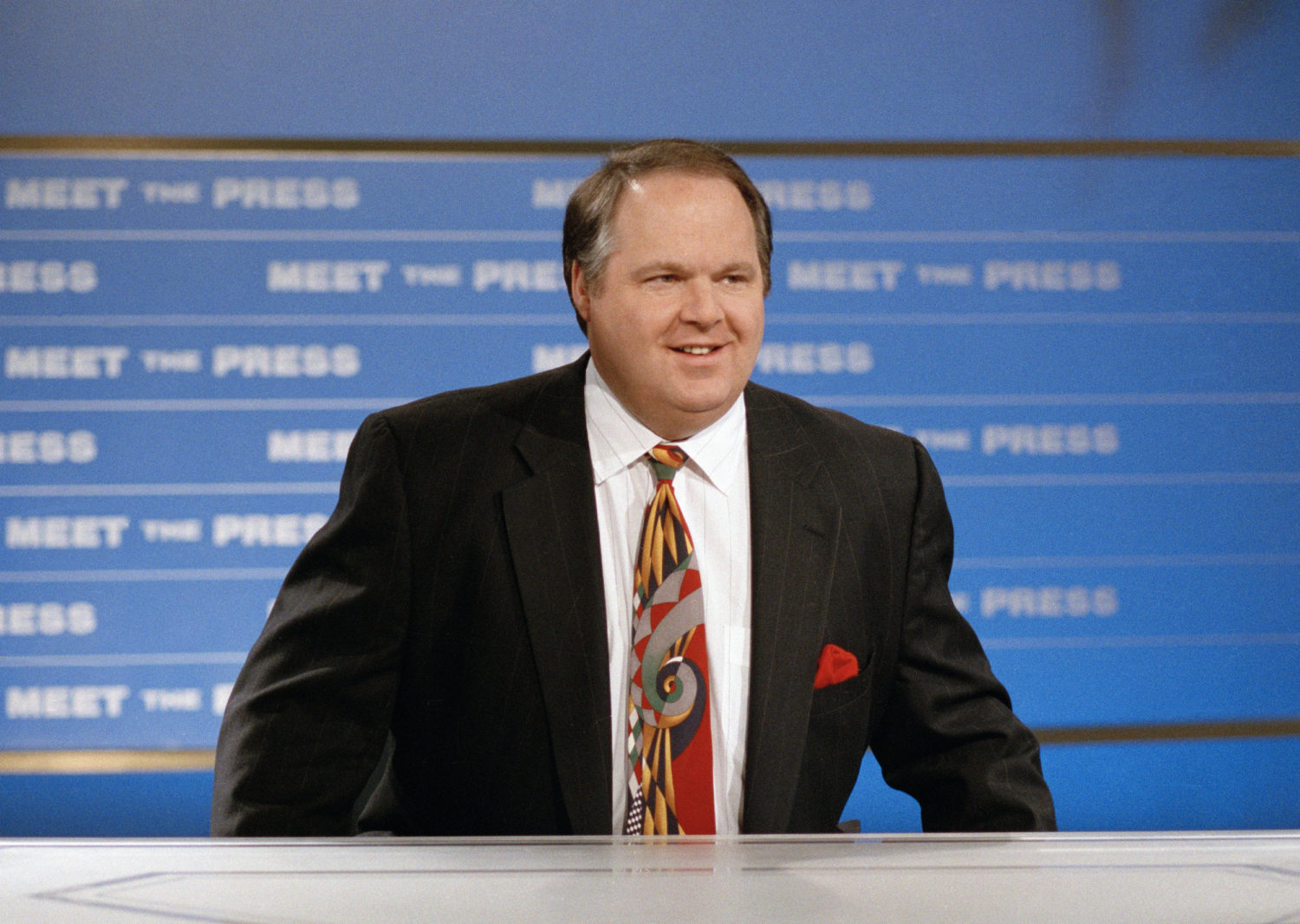Rush Limbaugh was more than a talk radio host. He was a key element in the development of the highly partisan journalism and other media that envelop us today.
Limbaugh’s talk radio program was not possible until the Federal Communications Commission relaxed the fairness doctrine. That policy, which began in 1949, was rooted in the idea that radio and TV stations were “public trustees” and as such should serve the entire nation and on the local level serve the communities to which they were licensed. The doctrine required them to air competing views on important issues. The idea was for broadcasters not to take sides.
The Congressional Research Service, known as Congress’ think tank, said fairness doctrine required that broadcasters “devote a reasonable portion of broadcast time to the discussion and consideration of controversial issues of public importance” and “affirmatively endeavor to make … facilities available for the expression of contrasting viewpoints held by responsible elements with respect to the controversial issues.”
Consequences for a failure to comply with the fairness doctrine ranged from a requirement that time be granted to unaired viewpoints to punishment as severe as the loss of license or a substantial demerit in a license renewal proceeding.
But what about free speech? What about news and journalism? Did news programs have to concede airtime to “both sides?” The Supreme Court upheld the fairness doctrine in a lawsuit called Red Lion Broadcasting Co. Inc. v. FCC in which a radio station host attempted to discredit journalist Fred J. Cook. The court riling summarized:
On November 27, 1964, WGCB carried a 15-minute broadcast by the Reverend Billy James Hargis as part of a “Christian Crusade” series. A book by Fred J. Cook entitled “Goldwater – Extremist on the Right” was discussed by Hargis, who said that Cook had been fired by a newspaper for making false charges against city officials; that Cook had then worked for a Communist-affiliated publication; that he had defended Alger Hiss and attacked J. Edgar Hoover and the Central Intelligence Agency, and that he had now written a “book to smear and destroy Barry Goldwater.”
Cook demanded equal time and the station said no. Cook sued.
While the lawsuit inched through the courts, the FCC began refining its fairness policies partly in anticipation that the Supreme Court would uphold the FCC rule, which it did.
In the Red Lion case, the court ruled that free speech is “the right of the viewers and listeners, not the right of the broadcasters.” And the court said stations should provide ample time for opposing views.
[the_ad id=”667826″]
Along came President Ronald Reagan who, like other conservatives, didn’t like the fairness doctrine. The feeling was that news media lean liberal and the marketplace should determine content. With the support of FCC Commissioner Mark S. Fowler, the commission announced in 1987 that the government would no longer enforce the fairness doctrine. The commission reasoned that with the rise of cable television there were lots of viewpoints available to the public that did not exist when only print and over-the-air broadcasting were the only conduits to the public.
(As a matter of broadcast trivia, the repeal of the doctrine occurred after a complaint against the television station WTVH in Syracuse, New York. The FCC declined to sanction the station for a violation of the fairness doctrine, because the agency determined that the doctrine violated the First Amendment.)
The Washington Post summarized what happened next:
Almost overnight, the media landscape was transformed. The driving force was talk radio. In 1960, there were only two all-talk radio stations in America; by 1995, there were 1,130. While television news on the old networks and the cable upstart CNN still adhered to the standard of objectivity, radio emerged as a wide-open landscape.
The public readily responded to the new model Limbaugh advanced after the demise of the Fairness Doctrine. By 1994, he had an audience of 20 million Americans tuning in on some 650 stations. “What Rush realizes, and what a lot of listeners don’t,” an Atlanta station manager explained, “is that talk-radio programming is entertainment, it is not journalism.”
Conservative voices had long been ignored in the mainstream media, they claimed, but now that the free market had been unchained, it was clear what the people wanted. By 1995, conservatives accounted for roughly 70 percent of all talk-radio listeners. The end of the Fairness Doctrine had drastically changed the standards of news.
The Congressional Research Service recounted:
Many broadcasters complained that the Fairness Doctrine was overly burdensome and inhibited their ability to cover issues of public importance. Those in favor of the doctrine believed that it ensured vibrant discussion over the public airwaves. After a number of proceedings examining the effects of the Fairness Doctrine on broadcasters, the FCC abolished the doctrine in 1987. The FCC reasoned that increased competition in the marketplace, First Amendment concerns, and evidence that the Fairness Doctrine actually chilled speech rather than facilitating it justified abandoning the policy.
The FCC decision didn’t change the rule the requires broadcasters to give equal time to candidates for public office and also, for a time, the provision that required stations to give equal time to subjects attacked in editorials and personal attacks. But even those remnants of the rule were repealed in 2000.
The fairness doctrine was technically removed from the books in 2011 but had lost its teeth years before.
My friend, WTMJ (Milwaukee) radio host Gene Mueller told me that under fairness doctrine rules, radio station hosts like him “were supposed to just be hosts, the callers were the stars.”
“But then,” he said, “everything changed. Suddenly everybody had to have a take, an angle. The nature of the beast changed. The talk show host became the star.”
Mueller hosts a “news wheel” program on WTMJ radio now but said when he filled in for a talk show, a program director once advised him that to be successful, he “should tell the public why you bring up a subject, what your take is about that subject. You have to tell people why it is important.”
In other words, the host was now the center of attention.
Limbaugh knew that. In some ways, he invented the format in which hosts talks nonstop for hours. They pick fights with listeners and stake out political positions.
[the_ad id=”667872″]
That change that followed the repeal of the fairness doctrine not only gave voice to Rush Limbaugh, but Limbaugh’s success gave rise to others and provided encouragement for Fox News’ 1996 launch with Republican strategist Roger Ailes at the helm. Fox News launched with President Bill Clinton in its sights as a perfect target to relentlessly attack.
It would be incorrect to say the repeal of the fairness doctrine created Fox News, since Fox News is a cable company and cable TV content would not have fallen under FCC rules the way that over-the-air stations were. But Limbaugh’s talk radio work created an audience and appetite for what Fox News would generate.
Fox News and radio talk show host Sean Hannity said Limbaugh inspired a generation of conservative talk show hosts. “He stayed consistent,” Hannity said minutes after Limbaugh’s death was announced Wednesday. “Rush would give you a take on whatever the issues of the day were that you never thought of yourself, but you always wish you did.”
“I can’t imagine the next political battle without him,” Hannity said.
Former Vice President Mike Pence said Wednesday afternoon that he was a talk-radio host for a number of years and said, “I was inspired by Rush Limbaugh.”
“He reinvented AM radio,” Pence said. He said that Limbaugh’s format saved radio stations, which were in decline in the 1980s. “People were talking about whether they were going to turn off AM radio, but Rush Limbaugh changed all of that. He was a broadcast pioneer.”
Since the repeal of the fairness doctrine and the rise of conservative talk radio, congressional Democrats have tried several times to reimpose the rule. Almost as many times, Republicans have attempted to pass legislation forbidding the rule from ever being reimposed.
In the end, the fairness doctrine required broadcasters to decide which issues were important to the public and which points of view it should present in more or less equal measures. The FCC said it was not comfortable being involved in such decisions and wanted to leave it up to the broadcasters to decide what to air based on how the marketplace reacted.

(Screenshot)

(Screenshot)
Free from the shackles of the fairness doctrine, Limbaugh thrived on partisan battles and personal attacks. The fires that he ignited and fed generated heat even in the hours after his death. The headlines played him in equal parts hated and beloved. And that’s fair.
[the_ad id=”667878″]
More from Poynter: Loved and loathed — the death of talk radio legend Rush Limbaugh







